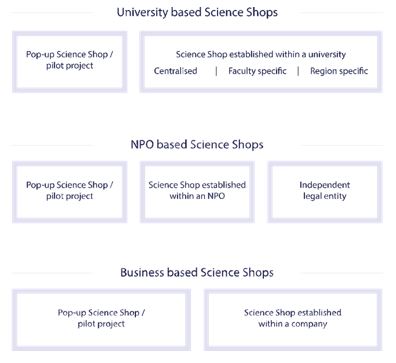When setting up a Science Shop there are many decisions that need to be taken about how the Science Shop will operate. How will it be staffed and funded? Where will it be located? Who will carry out the projects? Will it have a thematic focus and what type of projects will it carry out?
A new report produced by the EU SciShops project seeks to provide insights into some of the key aspects that influence how a Science Shop operates, their interdependencies, and how developments relating to these key aspects might affect its growth, stability or decline.
In order to reflect the diversity of existing and future models of Science Shops, the report looks at how these key aspects can play out in different types of Science Shops, including those based at universities, non-profit organisations, and businesses as well as ones established as independent legal entities.

Figure 1: Overview of organisational options by type of Science Shop addressed in the scenarios collection
The seven key aspects related to the operation of a Science Shop that are explored in the report are:
- Organisational model
- Funding
- Infrastructure
- Coordination staff
- Implementation staff
- Project type
- Thematic scope
For each of these aspects, possible operational options are identified and the advantages and disadvantag
| Advantages | Disadvantages | |
|---|---|---|
| Pop up / pilot |
|
|
| University: Centralised |
|
|
| University: Faculty specific |
|
|
| University: Regional |
|
|
| Based within NPO / SME |
|
|
| Independent legal entity |
|
|
Figure 2: Advantages and disadvantages of the different organisational models
The results of this analysis highlight some differences between Science Shops, especially between university-based and NPO-based Science Shops. Reflections on the business-based model, which are currently mainly hypothetical, indicate that these Science Shops might correspond more closely to the NPO-based model. University-based Science Shops have some particular advantages in terms of their better access to continuous securer funding, to students and supervisors, and to infrastructure, such as laboratories, libraries and dissemination channels. Thus, it is quite common for university-based Science Shops to conduct more projects on a wider range of topics.
On the other hand, Science Shops based at NPOs, and possibly businesses, are not dependent on governmental or university policies and requirements. They can therefore be more independent, flexible and creative, as well as more involved in action research, the facilitation of stakeholder engagement, and production of services and products for civil society more than research-oriented universities.
Science Shop life cycles
In addition, several key developments are identified for each key aspect. These developments consist of both challenges and opportunities, from both within and outside of the organisation, which can have a profound impact on how the Science Shop is run. For example, receiving project funding provides an opportunity for growth, while the end of project funding presents a challenge; a new member of staff joining a science shope may bring in new competencies and opportunities for new projects, while the loss of a key person can present a threat.
All options and developments are illustrated with real-life case studies, wherever possible. As the examples show, the life cycle of a science is rarely a linear process and many science shops undergo periods of growth and decline, often due to changing conditions and environments. The report highlights also some of the options for science shops when facing these types of challenges.
Read the whole report D 4.1 Science Shops Scenarios Collection

